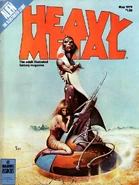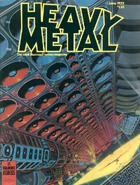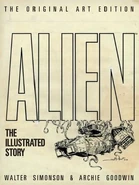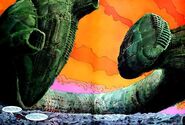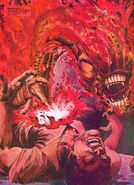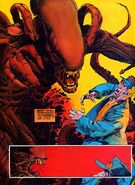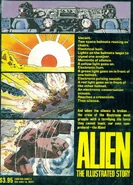Leigh Burne (talk | contribs) No edit summary Tag: sourceedit |
Leigh Burne (talk | contribs) Tag: sourceedit |
||
| (43 intermediate revisions by 2 users not shown) | |||
| Line 7: | Line 7: | ||
|illustrator = [[Walt Simonson]] |
|illustrator = [[Walt Simonson]] |
||
|inker = |
|inker = |
||
| − | |letterer = |
+ | |letterer = John Workman |
|colorist = |
|colorist = |
||
| − | |cover artist = |
+ | |cover artist = Walt Simonson |
|editor = [[Charles Lippincott]] |
|editor = [[Charles Lippincott]] |
||
|publisher = Futura Publications Limited<br>[[Titan Books]] (reissue) |
|publisher = Futura Publications Limited<br>[[Titan Books]] (reissue) |
||
| − | |released = 1979<br>September 7, [[2012]] (reissue) |
+ | |released = June [[1979]]<br>September 7, [[2012]] (reissue) |
|pages = 64<br>96 (Original Art Edition) |
|pages = 64<br>96 (Original Art Edition) |
||
|isbn = |
|isbn = |
||
| Line 21: | Line 21: | ||
|chronology = |
|chronology = |
||
|preceded by = |
|preceded by = |
||
| − | |followed by = |
+ | |followed by = }} |
| ⚫ | '''''Heavy Metal Presents Alien: The Illustrated Story''''', also known as '''''Alien: The Illustrated Story''''', is a graphic novel adaptation of [[Alien (film)|film of the same name]] that was first published by ''Heavy Metal'' magazine in June [[1979]]. It was written by [[Archie Goodwin]], based on the original screenplay by [[Dan O'Bannon]], illustrated by [[Walt Simonson]], lettered by John Workman and edited by [[Charles Lippincott]], with cover art by Simonson. |
||
| − | |alternate image = Alien_01.jpg |
||
| ⚫ | |||
| ⚫ | '''''Heavy Metal Presents Alien: The Illustrated Story''''' is a graphic novel adaptation of [[Alien (film)|film of the same name]] |
||
| − | Following the original publication, the next ''Alien'' franchise-related comic book to be released would be [[1988]] |
+ | Following the original publication, the next ''Alien'' franchise-related comic book to be released would be the [[1988]] series ''[[Aliens (1988 comic series)|Aliens]]'', a sequel to [[James Cameron]]'s [[Aliens (film)|film of the same name]], by the then-recently formed [[Dark Horse Comics]]. This would go on to spawn an entire line of [[Aliens (comics line)|''Aliens'' comics]] by Dark Horse that continues until the present. As Dark Horse had no involvement with the original ''Alien'' adaptation (and do not hold the rights to it), it is not considered a part of the company's ''Aliens'' line and has never been collected in any form with the later Dark Horse releases. |
==Publisher's Summary== |
==Publisher's Summary== |
||
| Line 32: | Line 30: | ||
''And when the silence is broken... the crew of the [[USCSS Nostromo|Nostromo]] must grapple with a terrifying life force they cannot leash, nor even comprehend — the [[The Alien (Xenomorph)|Alien]]!'' |
''And when the silence is broken... the crew of the [[USCSS Nostromo|Nostromo]] must grapple with a terrifying life force they cannot leash, nor even comprehend — the [[The Alien (Xenomorph)|Alien]]!'' |
||
| − | |||
| ⚫ | |||
| ⚫ | The adaptation was released prior to [[Dark Horse Comics]] acquiring the license to produce ''Aliens'' comics following the release of {{A2}} in [[1986]] |
||
| − | |||
| ⚫ | Goodwin is also well known for being a former editor at Marvel Comics and long-time ''Star Wars'' comics writer/editor in comic book, daily strip, and movie adaptation forms. Simonson also worked on Marvel's ''Star Wars'' Comics, but would become renowned for his work on Marvel's ''Thor''. His future wife, Louise Jones, also served as an editor on Marvel's ''Star Wars'', on which the two worked together for a time. |
||
| − | |||
| ⚫ | |||
| ⚫ | |||
| ⚫ | |||
| − | |||
| ⚫ | |||
| ⚫ | Unusually for a comic book adaptation of a feature film, ''Alien: The Illustrated Story'' was critically acclaimed |
||
==Differences from the Film== |
==Differences from the Film== |
||
| Line 52: | Line 38: | ||
*Before landing on the [[Acheron (LV-426)|planetoid]], the crew listen to the transmission on the bridge. This scene was later added to the Director's Cut. |
*Before landing on the [[Acheron (LV-426)|planetoid]], the crew listen to the transmission on the bridge. This scene was later added to the Director's Cut. |
||
| − | *When exploring the [[Derelict (LV-426)|derelict]], [[ |
+ | *When exploring the [[Derelict (LV-426)|derelict]], [[Arthur Dallas|Dallas]] deactivates the beacon that brought the ''Nostromo'' to the moon by flicking a switch on the [[The Pilot|Pilot]]'s chair. |
*[[Joan Lambert|Lambert]] punches [[Ellen Ripley|Ripley]] when back aboard the ''Nostromo'' for her refusal to let them back on board. This scene was later added to the Director' Cut. |
*[[Joan Lambert|Lambert]] punches [[Ellen Ripley|Ripley]] when back aboard the ''Nostromo'' for her refusal to let them back on board. This scene was later added to the Director' Cut. |
||
| Line 66: | Line 52: | ||
*The fully-grown [[The Alien (Xenomorph)|Alien]] in the comic is huge, towering over its victims at anything between fifteen and twenty feet in height, although this size may just be for artistic impression. |
*The fully-grown [[The Alien (Xenomorph)|Alien]] in the comic is huge, towering over its victims at anything between fifteen and twenty feet in height, although this size may just be for artistic impression. |
||
| − | *Before killing Brett, the Alien stabs him in the back with its tail and lifts him up to deliver the killing [[Headbite]]. |
+ | *Before killing [[Brett]], the Alien stabs him in the back with its tail and lifts him up to deliver the killing [[Headbite]]. |
*Before he is taken by the Alien, Dallas passes by Lambert and Parker as he crawls through the vents, briefly acknowledging their presence. In the film, Dallas never encounters any of the crew again after entering the vents. |
*Before he is taken by the Alien, Dallas passes by Lambert and Parker as he crawls through the vents, briefly acknowledging their presence. In the film, Dallas never encounters any of the crew again after entering the vents. |
||
| − | *After assuming command, Ripley asks Lambert if she has ever slept with Ash, to which she responds in the negative, further |
+ | *After assuming command, Ripley asks Lambert if she has ever slept with Ash, to which she responds in the negative, further fueling Ripley's suspicions. This footage was filmed for the movie but cut. |
| − | *When Ash confronts Ripley, he knocks her unconscious inside the [[MU-TH-UR 6000|Mother]] interface room, before dragging her out to the mess to kill her with the rolled-up magazine. The following fight is also slightly different — Parker beheads Ash with one of the [[Tracking device (Nostromo)|motion detectors]], not a fire extinguisher as in the film, and it is Ripley, not Lambert, who finally "kills" his beheaded body with one of the cattle prods. |
+ | *When Ash confronts Ripley, instead of talking to her, he immediately knocks her unconscious inside the [[MU-TH-UR 6000|Mother]] interface room, before dragging her out to the mess to kill her with the rolled-up magazine. The following fight is also slightly different — Parker beheads Ash with one of the [[Tracking device (Nostromo)|motion detectors]], not a fire extinguisher as in the film, and it is Ripley, not Lambert, who finally "kills" his beheaded body with one of the cattle prods. |
*Ash's [[Special Order 937]] is said to come from "Mil/Sci" (presumably some military/science research entity or division) rather than the company that operates the ship. |
*Ash's [[Special Order 937]] is said to come from "Mil/Sci" (presumably some military/science research entity or division) rather than the company that operates the ship. |
||
| Line 83: | Line 69: | ||
*After discovering the Alien has stowed away aboard the ''Narcissus'', Ripley theorizes that the Alien refrains from killing her immediately because it knows she is trapped, and is simply going to leave her alone until it requires her for food, at which point it will turn hostile. |
*After discovering the Alien has stowed away aboard the ''Narcissus'', Ripley theorizes that the Alien refrains from killing her immediately because it knows she is trapped, and is simply going to leave her alone until it requires her for food, at which point it will turn hostile. |
||
| + | |||
| + | *Ripley appears notably less afraid around the Alien when killing the creature aboard the ''Narcissus'', saying things like, "Good-bye you bastard," and "Guess again you son of a bitch," when flushing the creature outside and before activating the engines to blast it into space. |
||
| + | |||
| ⚫ | |||
| ⚫ | The adaptation was released prior to [[Dark Horse Comics]] acquiring the license to produce ''Aliens'' comics following the release of {{A2}} in [[1986]]; indeed, ''Alien: The Illustrated Story'' pre-dates the existence of Dark Horse Comics itself. The film adaptation was created by comics legends [[Archie Goodwin]] and [[Walt Simonson]] for the equally acclaimed ''Heavy Metal'' magazine, which had been started in 1974 as an American version of the French science fiction/fantasy/erotica magazine ''Métal Hurlant'' (literally "Howling Metal"). Prior to release, the comic was partially serialized in ''Heavy Metal'' — two eight-page segments from the beginning of the graphic novel were run to serve as a teaser for the full release,<ref name="CBR">{{cite web|title=Comic Book Resources - WALT SIMONSON REFLECTS ON "ALIEN: THE ILLUSTRATED STORY"|url=http://www.comicbookresources.com/?page=article&id=41835|accessdate=2014-11-12}}</ref> published in ''Heavy Metal'', Vol. III #1-2 from May-June 1979.<ref name="Hasslein1">{{cite web|title=Hasslein Blog - The Alien/Predator Comic Strips, Part One|url=http://hassleinbooks.blogspot.ca/2013/10/the-alienpredator-comic-strips-part-one.html|accessdate=2015-06-12}}</ref> Due to an editing oversight, the title used at the start of the second of these preview segments was erroneously retained in the full release, although this was removed for the 2012 reissue.<ref name="CBR"/> |
||
| + | |||
| ⚫ | Goodwin is also well known for being a former editor at Marvel Comics and long-time ''Star Wars'' comics writer/editor in comic book, daily strip, and movie adaptation forms. Simonson also worked on Marvel's ''Star Wars'' Comics, but would become renowned for his work on Marvel's ''Thor''. His future wife, Louise Jones, also served as an editor on Marvel's ''Star Wars'', on which the two worked together for a time. |
||
| + | |||
| ⚫ | |||
| ⚫ | Unusually for a comic book adaptation of a feature film, ''Alien: The Illustrated Story'' was critically acclaimed and it became the first graphic novel ever to make the ''New York Times'' Best Seller list.<ref name="Joe">{{cite web|title=Joe Blogs - Alien – The Illustrated Story: Original Art Edition|url=https://wharferj.wordpress.com/2013/10/24/alien-the-illustrated-story-original-art-edition/|accessdate=2015-04-20}}</ref> Some have even labelled the comic superior to the movie upon which it is based.<ref name="CBR"/> Simonson later commented that [[20th Century Fox]] themselves expressed a reservation for the distinctive cover artwork, as they considered it to be superior to the posters that had been created for the film itself.<ref name="CBR"/> |
||
| + | |||
| + | ==Reprint History== |
||
| ⚫ | |||
| + | The comic adaptation of ''Alien'' was reprinted and re-released by [[Titan Books]] in September [[2012]], this time simply called ''Alien: The Illustrated Story''. This edition was colored by Polly Law, Bob K. LeRose, Deb Pedlar and Louise Simonson (wife of [[Walt Simonson]]) — the original release had been black and white — and featured a different cover, using art of the Alien taken from the scene where it attacks Brett by Walt Simonson. |
||
| + | |||
| ⚫ | |||
| + | Following the comic's reissue in 2012, an oversized, expanded Original Art Edition was also released, containing the comic in its original black and white format, scanned directly from Simonson's original art boards; the only alterations made to the scanned images was to add the comic's lettering, as this was originally added later. Even signs of corrections and stains on the original art that were cleaned up for previous printings of the comic were retained in this release. |
||
| + | |||
| ⚫ | The expanded edition also included a wealth of additional content, including the comic's script (by Goodwin), coloring examples and an interview with the creators revealing more on how the comic came to be, the writing process and Simonson's trip to England to see the film being made. The Original Art Edition was released in the hardcover format with Walt Simonson's cover from the original graphic novel, presented in black and white. |
||
| + | |||
| + | ==Trivia== |
||
| + | *''Heavy Metal'' also produced the making-of book ''[[The Book of Alien]]'', via their book imprint Heavy Metal Press. |
||
==Editions== |
==Editions== |
||
| Line 91: | Line 99: | ||
==Gallery== |
==Gallery== |
||
<gallery> |
<gallery> |
||
| + | HeavyMetal3.1.jpg|Cover to ''Heavy Metal'', Vol. III #1, containing the first preview segment of the graphic novel, by Peter Andrew Jones |
||
| ⚫ | |||
| + | HeavyMetal3.2.jpg|Cover to ''Heavy Metal'', Vol. III #2, containing the second preview segment, by Angus McKie |
||
| ⚫ | |||
| ⚫ | |||
| ⚫ | |||
| + | HMPATSopening.jpg|The opening pages |
||
| ⚫ | |||
| ⚫ | |||
| ⚫ | |||
| ⚫ | |||
| ⚫ | |||
</gallery> |
</gallery> |
||
| Line 106: | Line 118: | ||
==References== |
==References== |
||
<references/> |
<references/> |
||
| − | [[Category:Comics]] |
||
[[Category:Movie adaptation comics]] |
[[Category:Movie adaptation comics]] |
||
| − | [[Category: |
+ | [[Category:Non-Dark Horse comics]] |
[[Category:Stories set in the 22nd century]] |
[[Category:Stories set in the 22nd century]] |
||
| + | [[Category:Alien (film) merchandise]] |
||
Revision as of 15:42, 7 October 2015
Template:Alien Heavy Metal Presents Alien: The Illustrated Story, also known as Alien: The Illustrated Story, is a graphic novel adaptation of film of the same name that was first published by Heavy Metal magazine in June 1979. It was written by Archie Goodwin, based on the original screenplay by Dan O'Bannon, illustrated by Walt Simonson, lettered by John Workman and edited by Charles Lippincott, with cover art by Simonson.
Following the original publication, the next Alien franchise-related comic book to be released would be the 1988 series Aliens, a sequel to James Cameron's film of the same name, by the then-recently formed Dark Horse Comics. This would go on to spawn an entire line of Aliens comics by Dark Horse that continues until the present. As Dark Horse had no involvement with the original Alien adaptation (and do not hold the rights to it), it is not considered a part of the company's Aliens line and has never been collected in any form with the later Dark Horse releases.
Publisher's Summary
Vacant.
Two space helmets resting on chairs.
Electrical hum.
Lights on the helmets begin to signal one another.
Moments of silence.
A yellow light goes on.
Electronic hum.
A green light goes on in front of one helmet.
Electronic pulsing sounds.
A red light goes on in front of the other helmet.
An electronic conversation ensues.
Reaches a crescendo.
Then silence.
And when the silence is broken... the crew of the Nostromo must grapple with a terrifying life force they cannot leash, nor even comprehend — the Alien!
Differences from the Film
The graphic novel generally follows the plot and visuals of the feature film, although in a condensed form owing to the nature of the format. It also includes several scenes cut from the theatrical version of the film (including several that were later added in the Director's Cut).
- When the crew wakes from hypersleep, Kane is the first to rise and begins preparing breakfast for the others. This sequence was partially filmed for the movie, but was never completed and dropped from the final cut.
- Before landing on the planetoid, the crew listen to the transmission on the bridge. This scene was later added to the Director's Cut.
- When exploring the derelict, Dallas deactivates the beacon that brought the Nostromo to the moon by flicking a switch on the Pilot's chair.
- Lambert punches Ripley when back aboard the Nostromo for her refusal to let them back on board. This scene was later added to the Director' Cut.
- An added scene has Ripley interrupting Parker and Brett over the intercom as they make repairs, and Parker and Ripley trade insults. Parker hangs up and calls her a bitch before continuing with his work. This footage was shot but not included in the film.
- While discussing the last-minute replacement of the ship's regular science officer with Ash, Dallas points out that Ripley was also a last-minute addition to the crew.
- Kane's funeral goes unseen in the comic, happening "off-screen".
- Following Kane's funeral, Dallas questions Ash in the medical bay, his suspicions raised by the fact he allowed the alien organism back on board the ship. A much longer version of this scene was planned for the film, and appears in the novelization.
- The fully-grown Alien in the comic is huge, towering over its victims at anything between fifteen and twenty feet in height, although this size may just be for artistic impression.
- Before killing Brett, the Alien stabs him in the back with its tail and lifts him up to deliver the killing Headbite.
- Before he is taken by the Alien, Dallas passes by Lambert and Parker as he crawls through the vents, briefly acknowledging their presence. In the film, Dallas never encounters any of the crew again after entering the vents.
- After assuming command, Ripley asks Lambert if she has ever slept with Ash, to which she responds in the negative, further fueling Ripley's suspicions. This footage was filmed for the movie but cut.
- When Ash confronts Ripley, instead of talking to her, he immediately knocks her unconscious inside the Mother interface room, before dragging her out to the mess to kill her with the rolled-up magazine. The following fight is also slightly different — Parker beheads Ash with one of the motion detectors, not a fire extinguisher as in the film, and it is Ripley, not Lambert, who finally "kills" his beheaded body with one of the cattle prods.
- Ash's Special Order 937 is said to come from "Mil/Sci" (presumably some military/science research entity or division) rather than the company that operates the ship.
- Ripley activates the Nostromo's self destruct system before Parker and Lambert are killed, not after as in the movie.
- As she attempts to flee to the Narcissus, Ripley encounters a strange box in a corridor, which unfolds and reveals itself to be the Alien. This scene was supposedly shot, but in the final film Ripley merely encounters the Alien around a corner.
- After failing to abort the self destruct, Ripley incinerates one of Mother's computer banks in frustration.
- After discovering the Alien has stowed away aboard the Narcissus, Ripley theorizes that the Alien refrains from killing her immediately because it knows she is trapped, and is simply going to leave her alone until it requires her for food, at which point it will turn hostile.
- Ripley appears notably less afraid around the Alien when killing the creature aboard the Narcissus, saying things like, "Good-bye you bastard," and "Guess again you son of a bitch," when flushing the creature outside and before activating the engines to blast it into space.
Development
The adaptation was released prior to Dark Horse Comics acquiring the license to produce Aliens comics following the release of Aliens in 1986; indeed, Alien: The Illustrated Story pre-dates the existence of Dark Horse Comics itself. The film adaptation was created by comics legends Archie Goodwin and Walt Simonson for the equally acclaimed Heavy Metal magazine, which had been started in 1974 as an American version of the French science fiction/fantasy/erotica magazine Métal Hurlant (literally "Howling Metal"). Prior to release, the comic was partially serialized in Heavy Metal — two eight-page segments from the beginning of the graphic novel were run to serve as a teaser for the full release,[1] published in Heavy Metal, Vol. III #1-2 from May-June 1979.[2] Due to an editing oversight, the title used at the start of the second of these preview segments was erroneously retained in the full release, although this was removed for the 2012 reissue.[1]
Goodwin is also well known for being a former editor at Marvel Comics and long-time Star Wars comics writer/editor in comic book, daily strip, and movie adaptation forms. Simonson also worked on Marvel's Star Wars Comics, but would become renowned for his work on Marvel's Thor. His future wife, Louise Jones, also served as an editor on Marvel's Star Wars, on which the two worked together for a time.
Reception
Unusually for a comic book adaptation of a feature film, Alien: The Illustrated Story was critically acclaimed and it became the first graphic novel ever to make the New York Times Best Seller list.[3] Some have even labelled the comic superior to the movie upon which it is based.[1] Simonson later commented that 20th Century Fox themselves expressed a reservation for the distinctive cover artwork, as they considered it to be superior to the posters that had been created for the film itself.[1]
Reprint History
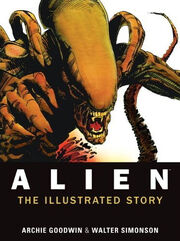
Cover to Alien: The Illustrated Story reissue by Walt Simonson.
The comic adaptation of Alien was reprinted and re-released by Titan Books in September 2012, this time simply called Alien: The Illustrated Story. This edition was colored by Polly Law, Bob K. LeRose, Deb Pedlar and Louise Simonson (wife of Walt Simonson) — the original release had been black and white — and featured a different cover, using art of the Alien taken from the scene where it attacks Brett by Walt Simonson.
The Original Art Edition
Following the comic's reissue in 2012, an oversized, expanded Original Art Edition was also released, containing the comic in its original black and white format, scanned directly from Simonson's original art boards; the only alterations made to the scanned images was to add the comic's lettering, as this was originally added later. Even signs of corrections and stains on the original art that were cleaned up for previous printings of the comic were retained in this release.
The expanded edition also included a wealth of additional content, including the comic's script (by Goodwin), coloring examples and an interview with the creators revealing more on how the comic came to be, the writing process and Simonson's trip to England to see the film being made. The Original Art Edition was released in the hardcover format with Walt Simonson's cover from the original graphic novel, presented in black and white.
Trivia
- Heavy Metal also produced the making-of book The Book of Alien, via their book imprint Heavy Metal Press.
Editions
- ISBN 0930368428; [1979], Simon & Schuster, paperback, 64 pages
- ISBN 978-1781161296; [September] [2012], Titan Books, paperback, 64 pages
- ISBN 978-1781161302; [October] [2012], Titan Books, hardcover, 72 pages
Gallery
See Also
- Alien (film) — The 1979 film.
- Alien (novel) — The novelization of the film by Alan Dean Foster.
External links
References
- ↑ 1.0 1.1 1.2 1.3 "Comic Book Resources - WALT SIMONSON REFLECTS ON "ALIEN: THE ILLUSTRATED STORY"". Retrieved on 2014-11-12.
- ↑ "Hasslein Blog - The Alien/Predator Comic Strips, Part One". Retrieved on 2015-06-12.
- ↑ "Joe Blogs - Alien – The Illustrated Story: Original Art Edition". Retrieved on 2015-04-20.

